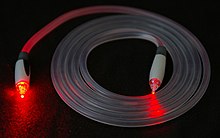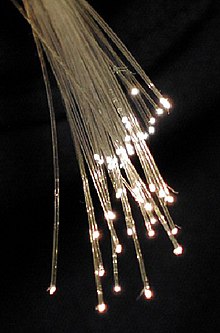Optical fiber
From Wikipedia, the free encyclopedia

An optical fiber is made up of the core (carries the light pulses), the cladding (reflects the light pulses back into the core) and the buffer coating (protects the core and cladding from moisture, damage, etc.). Together, all of this creates a fiber optic which can carry up to 10 million messages at any time using light pulses. Fiber optics is the overlap of applied science and engineering concerned with the design and application of optical fibers. Optical fibers are widely used in fiber-optic communications, which permits transmission over longer distances and at higher bandwidths (data rates) than other forms of communications. Fibers are used instead of metal wires because signals travel along them with less loss and are also immune to electromagnetic interference. Fibers are also used for illumination, and are wrapped in bundles so they can be used to carry images, thus allowing viewing in tight spaces. Specially designed fibers are used for a variety of other applications, including sensors and fiber lasers.
Light is kept in the core of the optical fiber by total internal reflection. This causes the fiber to act as a waveguide. Fibers which support many propagation paths or transverse modes are called multi-mode fibers (MMF), while those which can only support a single mode are called single-mode fibers (SMF). Multi-mode fibers generally have a larger core diameter, and are used for short-distance communication links and for applications where high power must be transmitted. Single-mode fibers are used for most communication links longer than 550 meters (1,800 ft).
Joining lengths of optical fiber is more complex than joining electrical wire or cable. The ends of the fibers must be carefully cleaved, and then spliced together either mechanically or by fusing them together with an electric arc. Special connectors are used to make removable connections.

No comments:
Post a Comment